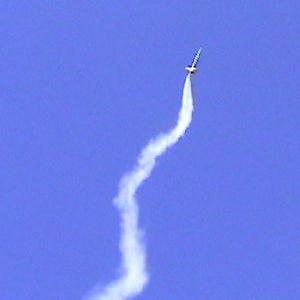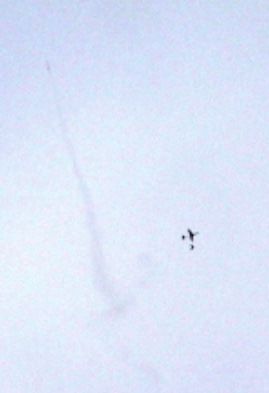Scratch Compensation Issues Original Design / Scratch Built
Scratch - Compensation Issues {Scratch}
Contributed by Jeff Lane
| Manufacturer: | Scratch |

Brief:
Parallel cluster booster with sliding tail glider recovery, vented gap staging,
2 D- or 2 E-engine cluster and 5 foot tall sustainer.
Construction:
Sustainer final 5-foot tall configuration: Ninja BT-60s, BT-50 with plastic
nose cone and 3/32 inch balsa fins. ¼inch launch lugs, 24mm engine mount
with foam core centering rings, rear bulkhead/external tape engine retention,
and elastic shock cord. The BT50-60 transition is balsa.
Main booster: BT-60, foam core centering rings, BT-50 engine mount, ¼inch launch lugs, 3/32 inch balsa fins.
Parallel booster/glider: ¼ inch balsa, BT-5 sliding tail section, basswood boom, BT-50 main body/engine mount, 1/8 inch plywood, 1mm brass rod for main clamp.
This would be a unique and exciting concept to kit for just about any manufacturer. The parallel cluster part of the 2006 Challenge was the impetus for this design. Parallel clusters are great but the existing drop-off pod designs are a little lacking in excitement. The sliding mechanisms on rocket gliders appeared to be ideal for doing double duty as a clamping mechanism for a parallel cluster. It's a natural marriage.
This is a rocket that's guaranteed to wow the kids. It's tall and extremely impressive looking, but where it really hits its stride is when it flies. It roars off the pad on the main booster with a parallel cluster clamped to the side. After staging, the parallel cluster glider ejects from the main booster body and spirals majestically down. The main booster has tumble recovery. The sustainer continues to rocket into the sky. This may be the first time a gliding parallel cluster model rocket has ever been designed and flown successfully.
Flight characteristics: One might think it would arch over under thrust because of the lift characteristics of the glider wing but it flies great.
Build: This is a demanding model to build. Booster thrust and staging is always truly impressive! (See flight video at http://www.brandango.us/htmlpages/rocketvideos.html)
The test R&D example has survived 6 flights and is ready for more, so it's proven sturdy.

Flight:
Prep is time consuming because you have to wrap bulkheads, make a burn string
for the glider, and trim the glider with empty engine casings.
First flight: the main booster came in ballistic. The 6-foot tall sustainer was marginally stable. The glider stalled way too much. [Main booster D12-0/Parallel booster glider D12-3, Sustainer C6-3.]
After this flight, the main booster was completely redesigned to achieve tumble recovery. The tail of the sustainer was reconfigured to add more fin and change from 18mm to 24mm engine mount. And some body tube was added to the nose of the glider to move the CG forward.
The second flight was a mess. With the main booster redesigned, the fins on it were too small and the rocket corkscrewed violently under boost. There wasn't enough velocity so even though the sustainer had more fin, it was unstable so it looped and crashed. The glider didn't separate from the main booster so it came down hard but there was no damage. [Main booster D12-0/Parallel booster glider D12-3, Sustainer C11-5.]
After this flight, one of the main booster fins was substantially enlarged (4x) and the sustainer fins were doubled in size to stop the corkscrewing. Also the booster-to-glider mounts were shortened from 1/2 inch to 1/4 inch for better booster/glider separation. And the nose section was rebuilt with a new (simpler, shorter) configuration.
Third flight: The B6-4 delay was too long and ejection came a tenth of a second before the main booster/parallel glider assembly landed in my truck. Two rockets lying in my truck bed were smashed but the glider and main booster were fine. The sustainer flew perfectly. [Main booster C11-0/Parallel booster glider B6-4, Sustainer C11-5.]
The fourth flight didn't have any changes in the hardware. The glider didn't separate from the main booster and the assembly landed hard but no damage. The sustainer didn't eject until just before lawn darting after what seemed like a twelve second delay. [Main booster D11-0/Parallel booster glider D12-3, Sustainer D12-7.]
After this flight, the accordion section (3 inches) on the front of the sustainer body was removed. The booster-to-glider mounts were reshaped to allow the glider to fall off easily upon ejection.
 Fifth flight: First perfect flight. Great liftoff, staged
with a good, solid pop, main booster separated from parallel glider a second
after booster drop off, good fast flat glide after a heart-stopping dive to
pick up speed (that could use a tiny bit more stall), and sustainer worked
great. Main booster landed on asphalt and knocked a fin loose, but it's fixed.
There's a small scorch mark on the glider body tube from the main booster, but
it's not enough for a redesign. [Main booster D11-0/Parallel booster glider
B6-2, Sustainer B4-4.]
Fifth flight: First perfect flight. Great liftoff, staged
with a good, solid pop, main booster separated from parallel glider a second
after booster drop off, good fast flat glide after a heart-stopping dive to
pick up speed (that could use a tiny bit more stall), and sustainer worked
great. Main booster landed on asphalt and knocked a fin loose, but it's fixed.
There's a small scorch mark on the glider body tube from the main booster, but
it's not enough for a redesign. [Main booster D11-0/Parallel booster glider
B6-2, Sustainer B4-4.]
No changes were made after this flight other than to adjust the glider CG for a bit more stall.
Sixth flight: Excellent flight. slow, impressive liftoff, good staging, main booster separated from parallel glider immediately after sustainer ignition, spiral flat glide (still needs more stall), and sustainer worked great although the parachute only partly deployed. One wing was split but was fixed. [Main booster D11-0/Parallel booster glider B6-2, Sustainer C6-5.]
After this flight a little weight in the form of some epoxy was added to the outer wing to widen the glide spiral.
Summary:
PRO: Guaranteed to elicit screams of delight from kids and draw a crowd of
level 1 through 3 fliers to find out how it works. The vented gap staging
always works great. Thanks, Trip.
CON: 3 engines make it pricey to fly. Prep time is considerable.
 |
 |